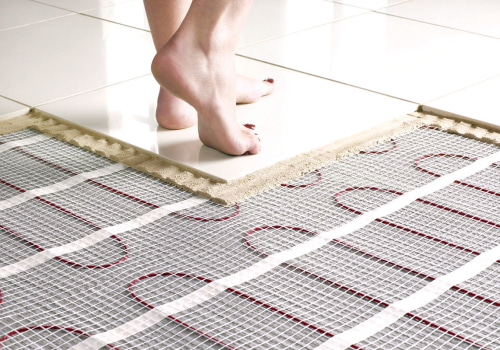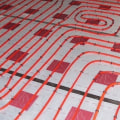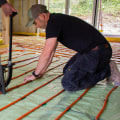Underfloor heating has gained popularity as a modern and efficient way to heat homes, offering a combination of comfort and energy efficiency. This heating method involves installing heating elements or water-filled pipes beneath the flooring, which then radiate heat upwards to warm the room. Unlike traditional heating systems that rely on radiators or forced air, underfloor heating provides consistent warmth from the ground up, creating a more evenly heated space. But is underfloor heating more cost-effective compared to other heating methods? To answer this question, we need to examine the initial installation costs, operating expenses, and long-term benefits associated with underfloor heating.
The Initial Costs of Underfloor Heating
One of the first factors to consider when evaluating the cost-effectiveness of underfloor heating is the initial installation cost. Underfloor heating systems can be more expensive to install than traditional heating systems, particularly if they are retrofitted into an existing home. The installation process involves laying down the heating elements or pipes beneath the floor, which may require lifting and replacing flooring materials. Additionally, if the system is water-based, it will need to be connected to a boiler or heat pump, adding to the complexity and cost of installation.
However, the installation costs can vary widely depending on the type of underfloor heating system chosen (electric or water-based), the size of the area to be heated, and the type of flooring material. For new builds or major renovations, the installation costs may be more manageable, as the system can be integrated into the construction process. Additionally, many homeowners find that the long-term savings on energy bills can offset the higher initial investment, making underfloor heating a cost-effective choice in the long run.
Operating Costs and Energy Efficiency
Once installed, underfloor heating systems are known for their energy efficiency, which can lead to lower operating costs over time. Underfloor heating works by evenly distributing heat across the entire floor surface, which allows the system to operate at lower temperatures compared to traditional radiators. Because the heat is radiated from the ground up, it creates a comfortable environment at a lower thermostat setting, which can result in significant energy savings.
For example, underfloor heating systems typically operate at temperatures between 29°C and 35°C (84°F to 95°F), while traditional radiators may need to be heated to 65°C to 75°C (149°F to 167°F) to achieve the same level of comfort. This lower operating temperature reduces energy consumption, especially when the system is paired with a high-efficiency boiler or heat pump. As a result, homeowners can see a noticeable reduction in their heating bills, particularly in well-insulated homes where the system’s efficiency is maximized.
Another advantage of underfloor heating is its compatibility with renewable energy sources, such as solar panels or geothermal heat pumps. When combined with these sustainable technologies, underfloor heating can further reduce energy costs and minimize the home’s carbon footprint. This makes it an attractive option for environmentally conscious homeowners looking to invest in a more sustainable heating solution.
Long-Term Benefits and Maintenance
In addition to energy savings, underfloor heating offers several long-term benefits that contribute to its overall cost-effectiveness. One of the most significant advantages is the even distribution of heat, which eliminates cold spots and drafts commonly associated with traditional heating systems. This consistent warmth enhances comfort and reduces the need to overheat certain areas to achieve a uniform temperature throughout the home.
Moreover, underfloor heating systems are generally low maintenance. Unlike radiators, which may require regular bleeding or repairs, underfloor heating systems have fewer moving parts and are less prone to breakdowns. Water-based systems, in particular, can last for decades with minimal maintenance, as they are protected by the flooring and not exposed to the wear and tear that radiators experience. Electric underfloor heating systems also require little upkeep, with most issues being related to the thermostat or control system rather than the heating elements themselves.
The durability and longevity of underfloor heating systems mean that homeowners can enjoy the benefits of efficient heating for many years without the need for frequent repairs or replacements. This reduces the long-term costs associated with maintaining the heating system and can add to the overall cost-effectiveness of the investment.
Professional Installation
To fully realize the cost-effectiveness of underfloor heating, it’s essential to ensure that the system is properly installed and tailored to the specific needs of the home. Companies like SureTech Heating & Cooling specialize in the installation and maintenance of underfloor heating systems, offering expert advice and services to help homeowners maximize their investment. Their experienced technicians can assess the home’s insulation, flooring type, and heating requirements to recommend the most suitable underfloor heating system, ensuring optimal efficiency and comfort.
By choosing a reputable service provider, homeowners can be confident that their underfloor heating system will be installed correctly, minimizing the risk of issues down the line and maximizing the system’s efficiency. Professional installation also ensures that the system is integrated seamlessly with other heating components, such as boilers or heat pumps, further enhancing its cost-effectiveness.
Conclusion
Underfloor heating offers a range of benefits that can make it a cost-effective choice for heating a home, particularly in the long term. While the initial installation costs may be higher than those of traditional heating systems, the energy efficiency, low operating costs, and minimal maintenance requirements of underfloor heating can lead to significant savings over time. Additionally, the enhanced comfort and compatibility with renewable energy sources make underfloor heating an attractive option for homeowners looking to invest in a sustainable and efficient heating solution. By working with professional service providers, homeowners can ensure that their underfloor heating system is installed and maintained to deliver the best possible performance, making it a wise investment for both comfort and cost savings.











